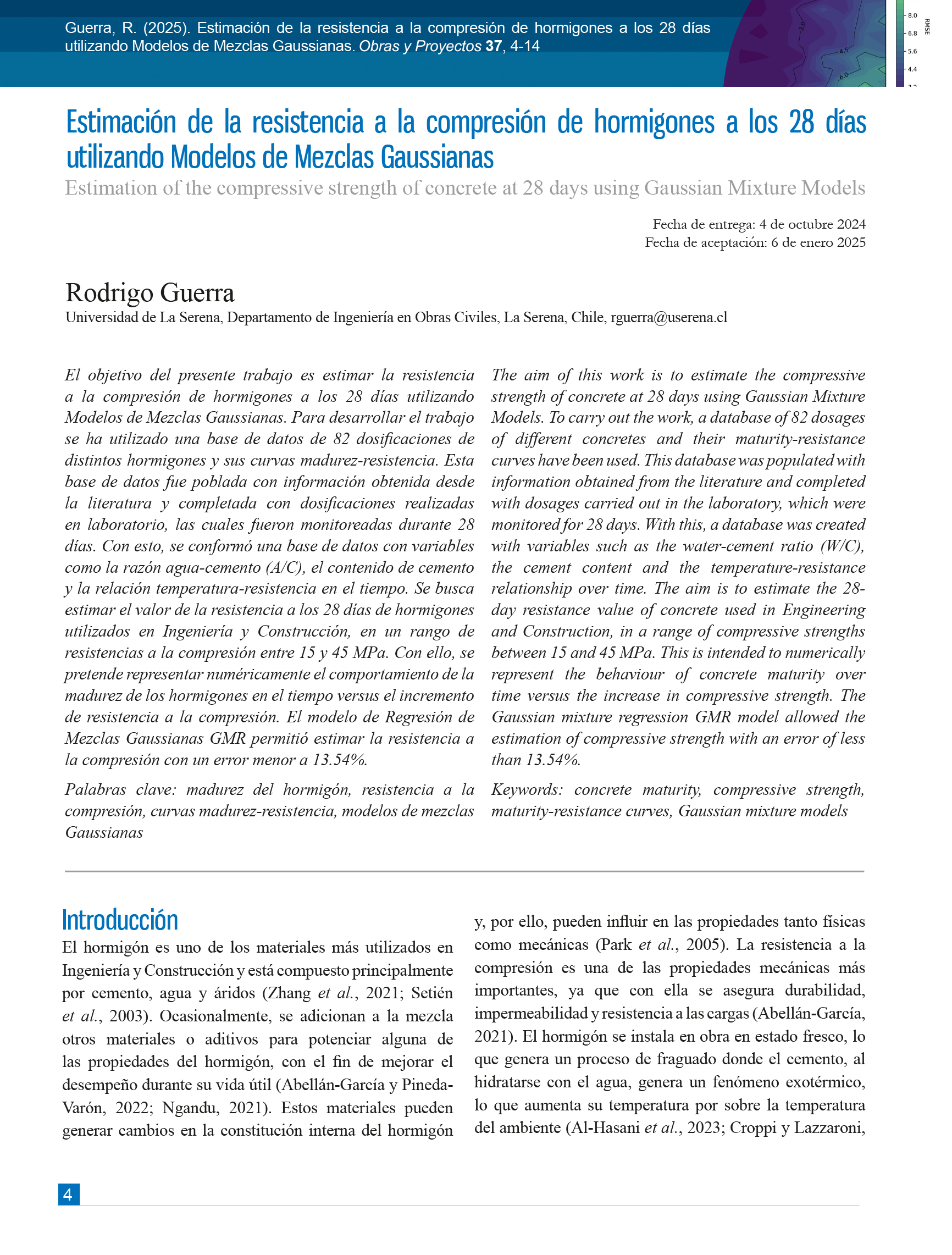Estimation of the compressive strength of concrete at 28 days using Gaussian Mixture Models
DOI:
https://doi.org/10.21703/0718-2813.2025.37.3230Keywords:
Concrete maturity, Compressive strength, Maturity-resistance curves, Gaussian mixture modelsAbstract
The aim of this work is to estimate the compressive strength of concrete at 28 days using Gaussian Mixture Models. To carry out the work, a database of 82 dosages of different concretes and their maturity-resistance curves have been used. This database was populated with information obtained from the literature and completed with dosages carried out in the laboratory, which were monitored for 28 days. With this, a database was created with variables such as the water-cement ratio (W/C), the cement content and the temperature-resistance relationship over time. The aim is to estimate the 28-day resistance value of concrete used in Engineering and Construction, in a range of compressive strengths between 15 and 45 MPa. This is intended to numerically represent the behaviour of concrete maturity over time versus the increase in compressive strength. The Gaussian mixture regression GMR model allowed the estimation of compressive strength with an error of less than 13.54%.
References
Abd elaty, M. abd allah. (2014). Compressive strength prediction of Portland cement concrete with age using a new model. HBRC Journal 10(2), 145-155. https://doi.org/10.1016/j.hbrcj.2013.09.005
Abdel-Jawad, Y.A. (2006). The maturity method: Modifications to improve estimation of concrete strength at later ages. Construction and Building Materials 20(10), 893-900. https://doi.org/10.1016/j.conbuildmat.2005.06.022
Abellán-García, J. and Pineda-Varon, F.A. (2022). Neural network-based model to predict compressive strength of concrete incorporating supplementary cementitious materials and recycled aggregates. Revista Matéria 27(2). https://doi.org/10.1590/s1517-707620220002.1318
Abellán-García, J. (2021). Predicción basada en redes neuronales de la resistencia a compresión a los 7 días de los UHPC incorporando SCM. Revista Matéria 26(4). https://doi.org/10.1590/s1517-707620210004.1380
Acuña, L., Torre, A.V., Moromi, I. y García, F. (2014). Uso de las redes neuronales artificiales en el modelado del ensayo de resistencia a compresión de concreto de construcción según la norma ASTM C39/C 39M. Información Tecnológica 25(4), 3-12. https://doi.org/10.4067/S0718-07642014000400002
Al-Hasani, L.E., Perez, G., Herndon, H.N., Park, J., Poole, J.L., Tien, I., Washburn, N.R., Cho, Y.K., Gentry, T.R. and Kurtis, K.E. (2023). Prediction of heat of hydration of cementitious systems using Gaussian process regression enables mass concrete thermal modeling. Materials and Structures 56:45, https://doi.org/10.1617/s11527-023-02134-8
ASTM C1074 (1987). Standard practice for estimating concrete strength by the maturity method. ASTM International, West Conshohocken, PA, USA.
Bishop, C. (2006). Pattern recognition and Machine Learning. Springer New York, USA. https://doi.org/10.53759/7669/jmc202404020
Buys, C.E. (2019). Investigation of a practical application of the maturity method to estimate the early- age strength of concrete. MEng thesis, Stellenbosch University, South Africa
Calinon, S., Guenter, F. and Billard, A. (2007). On learning, representing, and generalizing a task in a humanoid robot. IEEE Transactions on Systems, Man, and Cybernetics, Part B (Cybernetics) 37(2), 286-298. https://doi.org/10.1109/TSMCB.2006.886952
Chen, Z., Zhang, G., He, R., Tian, Z., Fu, C. and Jin, X. (2023). Acoustic emission analysis of crack type identification of corroded concrete columns under eccentric loading: A comparative analysis of RA-AF method and Gaussian mixture model. Case Studies in Construction Materials 18, e02021. https://doi.org/10.1016/j.cscm.2023.e02021
Croppi, J.I. y Lazzaroni, M.C. (2014). Modelo de elementos finitos para el análisis térmico de estructuras hormigonadas por etapas. Obras y Proyectos 16, 51-58. httpS://doi.org/10.4067/S0718-28132014000200004
Fabisch, A. (2021). gmr: Gaussian Mixture Regression. Journal of Open Source Software 6(62), 3054. https://doi.org/10.21105/joss.03054
Farhidzadeh, A., Salamone, S. and Singla, P. (2013). A probabilistic approach for damage identification and crack mode classification in reinforced concrete structures. Journal of Intelligent Material Systems and Structures 24(14), 1722-1735. https://doi.org/10.1177/1045389X13484101
Ghahramani, Z. and Jordan, M. (1994). Supervised learning from incomplete data via an EM approach. In J. Cowan, G. Tesauro, J. Alspector (eds.), Advances in Neural Information Processing Systems 6, 120-127
Kaneko, H. (2021). Extended Gaussian mixture regression for forward and inverse analysis. Chemometrics and Intelligent Laboratory Systems 213, 104325. https://doi.org/10.1016/j.chemolab.2021.104325
Kaneko, H. (2022). True Gaussian mixture regression and genetic algorithm-based optimization with constraints for direct inverse analysis. Science and Technology of Advanced Materials: Methods 2(1), 14-22. https://doi.org/10.1080/27660400.2021.2024101
Luk, B.L., Liu, K.P., Tong, F. and Man, K.F. (2010). Impactacoustics inspection of tile-wall bonding integrity via wavelet transform and hidden Markov models. Journal of Sound and Vibration 329(10), 1954-1967. https://doi.org/10.1016/j.jsv.2009.11.038
Mayakuntla, P.K., Ganguli, A. and Smyl, D. (2023). Gaussian mixture model-based classification of corrosion severity in concrete structures using ultrasonic imaging. Journal of Nondestructive Evaluation 42(2), 1-20. https://doi.org/10.1007/s10921-023-00939-9
Miller, D.; Ho, N.M. and Talebian, N. (2022). Monitoring of inplace strength in concrete structures using maturity method - An overview. Structures 44, 1081-1104. https://doi.org/10.1016/j.istruc.2022.08.077
Mohtasham Moein, M., Saradar, A., Rahmati, K., Ghasemzadeh Mousavinejad, S.H., Bristow, J., Aramali, V. and Karakouzian, M. (2023). Predictive models for concrete properties using machine learning and deep learning approaches: A review. Journal of Building Engineering 63, 105444. https://doi.org/10.1016/j.jobe.2022.105444
Nandhini, K. and Karthikeyan, J. (2021). The early-age prediction of concrete strength using maturity models: a review. Journal of Building Pathology and Rehabilitation 6:7. https://doi.org/10.1007/s41024-020-00102-1
NCh3565 (2018). Hormigón - Estimación de la resistencia mecánica- Método de la madurez. Instituto Nacional de Normalización INN, Santiago, Chile
NCh170 (2016). Hormigón - Requisitos generales. Instituto Nacional de Normalización INN, Santiago, Chile
Ngandu, C. N. (2021). Prediction of compressive strengths for rice husks ash incorporated concrete, using neural network and reviews. Iteckne 18(2), 99-107. https://doi.org/10.15332/iteckne
Park, K.B., Noguchi, T. and Plawsky, J. (2005). Modeling of hydration reactions using neural networks to predict the average properties of cement paste. Cement and Concrete Research 35(9), 1676-1684. https://doi.org/10.1016/j.cemconres.2004.08.004
Rudeli, N. y Santilli, A. (2017). Medición de resistencia a tempranas edades del hormigón: método que mejor se ajusta para la determinación de tiempos mínimos de desencofrado de elementos verticales de hormigón. Obras y Proyectos 22, 6-16. https://doi.org/10.4067/S0718-28132017000200006
Setién, J., Carrascal, I.A., Figueroa, J.F. y Polanco, J.A. (2003). Aplicación de una red neuronal artificial a la dosificación de hormigones premezclados. Materiales de Construcción 53(270), 221-224. https://doi.org/10.3989/mc.2003.v53.i270.270
Stulp, F. and Sigaud, O. (2015). Many regression algorithms, one unified model: A review. Neural Networks 69, 60-79. https://doi.org/10.1016/j.neunet.2015.05.005
Sun, H., Burton, H.V. and Huang, H. (2021). Machine learning applications for building structural design and performance assessment: State-of-the-art review. Journal of Building Engineering 33, 101816. https://doi.org/10.1016/j.jobe.2020.101816
Thai, H.T. (2022). Machine learning for structural engineering: A state-of-the-art review. Structures 38, 448-491. https://doi.org/10.1016/j.istruc.2022.02.003
Vidya Sagar, R. (2018). Verification of the applicability of the Gaussian mixture modelling for damage identification in reinforced concrete structures using acoustic emission testing. Journal of Civil Structural Health Monitoring 8(3), 395-415. https://doi.org/10.1007/s13349-018-0284-5
Zhang, L., Oh, S.K., Pedrycz, W., Yang, B. and Han, Y. (2021). Building fuzzy relationships between compressive strength and 3D microstructural image features for cement hydration using Gaussian mixture model-based polynomial radial basis function neural networks. Applied Soft Computing 112, 107766. https://doi.org/10.1016/j.asoc.2021.107766

Downloads
Published
Issue
Section
License
Copyright (c) 2025 Universidad Católica de la Santísima Concepción

This work is licensed under a Creative Commons Attribution-NonCommercial 4.0 International License.







